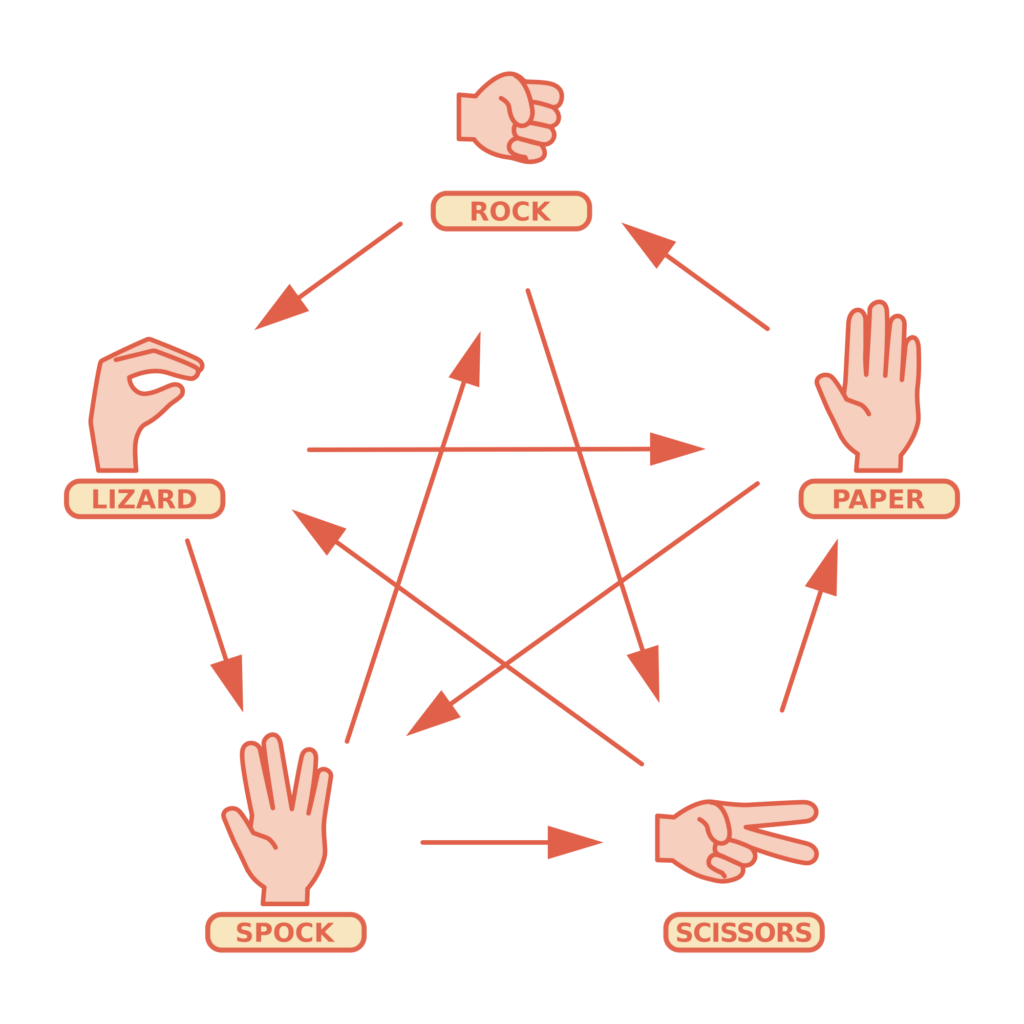Our understanding of the world relies heavily on relationships between things. We say a mountain is taller than a hill, a parent loves their child, and one concept leads to another. These connections, often expressed through verbs like “less than,” “loves,” and “leads to,” are transitive in nature. This means if A is connected to B, and B is connected to C, then A must also be connected to C. It’s a simple rule that governs interactions in various domains, from mathematics to social networks.
But what happens when this transitivity doesn’t hold true? Enter the intriguing world of non-transitive data, where relationships defy our intuitive expectations. In this article, we’ll delve into this fascinating realm, exploring its unique properties and the challenges and opportunities it presents.
When Logic Takes a Rock, Paper, Scissors Turn
Imagine rock-paper-scissors, but with a sci-fi twist! Let’s add “lizard” and “Spock” to the mix. Now, picture this: Alice confidently throws Spock, vaporizing Bob’s puny scissors. Emboldened, Bob throws a rock, pulverizing Charlie’s unsuspecting lizard. However, channelling their inner Spock, Charlie throws paper, logically outsmarting Alice’s Spock and sending it back to the depths of space. This creates a paradoxical loop: Alice overpowers Bob, Bob dominates Charlie, yet Charlie holds the upper hand against Alice – a clear violation of the transitivity we expect in our games!

This example, inspired by the rock-paper-scissors-lizard-Spock extension, perfectly demonstrates how unexpected relationships can emerge in non-transitive data. This data can arise in various contexts, from:
- Preferences: You might prefer action movies to comedies, while your friend prefers comedies to documentaries. But that doesn’t guarantee you’ll both dislike documentaries.
- Social Influence: You might follow a celebrity on Instagram, who follows a fashion influencer. However, the influencer might not follow you back, creating a non-transitive link.
The Paradox of Movie Data: When More Minutes Don’t Mean Higher Praise
The world of movies, brimming with diverse stories and styles, can also present fascinating challenges for data analysis. Take, for instance, the seemingly straightforward relationships between movie length, age, and rating. Each holds its own significance: longer movies offer deeper exploration, older films become cultural touchstones, and good ratings signify critical acclaim. However, exploring these traits together reveals a potential non-transitive paradox, where seemingly logical connections get tangled.
Imagine three iconic films:
- Movie A: “Gone With the Wind” (1939, 238 minutes, IMDb rating 8.1) – A classic, sprawling epic with enduring cultural impact.
- Movie B: “The Godfather” (1972, 177 minutes, IMDb rating 9.2) – A universally acclaimed masterpiece, praised for its depth and cinematic brilliance.
- Movie C: “Whiplash” (2014, 106 minutes, IMDb rating 8.3) – A modern, tautly paced film, acclaimed for its intensity and performances.
Here’s where the paradox emerges:
- Length vs. Age: Movie A is both the longest and oldest, suggesting a potential link between age and increasing length.
- Length vs. Rating: Movie B, though shorter than A, boasts a higher rating, implying a link between movie length and higher ratings.
- Age vs. Rating: However, comparing B and C shows a disconnect. Movie C, significantly younger than B, also has a high rating, contradicting the notion that older movies automatically receive higher praise.
This is where non-transitivity comes in. While each relationship might individually hold true, combining them creates a loop. The logical progression breaks down, revealing the nuances that defy simplistic interpretations.
Several factors contribute to this paradox:
- Genre and Context: Movie A’s epic genre lends itself to a longer runtime, while B’s crime drama unfolds more tightly. C’s modern thriller utilizes its shorter length for impactful storytelling. Genres and historical contexts influence both runtime and reception.
- Critical Evolution: Over time, critical perspectives and audience preferences change. Movie A’s classic status might overlook its flaws, while C’s modern themes might resonate more than B’s older ones.
- Subjectivity of Ratings: Ultimately, ratings are subjective opinions. While trends might emerge, individual assessments can deviate, creating non-transitive relationships.
Understanding this non-transitivity helps us analyze movie data more critically. Instead of linear conclusions, we recognize the multifaceted influences that shape film perception. From individual preferences to historical context, acknowledging the complexity enriches our understanding of how movies are made, received, and appreciated. The paradox reminds us that data, like movies themselves, isn’t always black and white. The true magic lies in appreciating the nuances and hidden connections that make storytelling truly captivating.
Navigating the Maze of Non-Transitivity
While fascinating, non-transitive data poses challenges for traditional analysis methods. Ranking algorithms built on transitivity assumptions might falter, leading to inaccurate results. Similarly, techniques utilizing “transitive closure” – assuming all indirect connections can be inferred – might provide misleading insights.
Embracing the Complexity: Unveiling Unseen Connections
Despite the challenges, non-transitive data holds immense potential. Recognizing its presence allows us to develop more nuanced and accurate models. For instance:
- Recommendation Systems: By considering non-transitivity, recommendation systems can move beyond simple “A liked X, B liked Y, therefore A will like Y” logic, leading to more personalized and relevant suggestions.
- Social Network Analysis: Accounting for non-transitive connections can reveal previously unseen patterns of influence and information flow within social networks, offering deeper insights into complex social dynamics.
Conclusion
Non-transitive data pushes us beyond the comfort zone of clean, transitive relationships. By embracing its complexity, we gain a deeper understanding of the interconnected world we inhabit. From seemingly simple games like rock-paper-scissors to the intricate networks of society and finance, non-transitive data holds the key to unlocking new possibilities and enriching our models of the world around us. So, the next time you play rock-paper-scissors, remember – there’s more to the game than meets the eye!
Leave a Reply